The Low-Waste Grafting Copolymerization Modification of Chitosan Is a Promising Approach to Obtaining Materials for Food Applications
Abstract
1. Introduction
2. Materials and Methods
2.1. Materials
2.2. Synthesis of Graft Copolymers of Chitosan and N-Vinylpyrrolidone
2.3. Characterization of the Cht-g-PVP Copolymers
2.3.1. FTIR-ATR
2.3.2. 1H NMR Spectroscopy
2.3.3. SEM
2.3.4. AFM
2.3.5. Polymer Thermal Research
2.3.6. Characterization of Grafted PVP Chains
2.3.7. XRD
2.3.8. Viscosity Measurement
2.4. Antibacterial and Toxicity Assays
3. Results and Discussion
3.1. Optimization of the Cht-g-PVP Synthesis Conditions
3.2. Characterization of Cht-g-PVP Copolymers
3.3. Prospects for the Application of Cht-g-PVP Copolymers in the Food Industry
4. Conclusions
Author Contributions
Funding
Institutional Review Board Statement
Data Availability Statement
Acknowledgments
Conflicts of Interest
References
- Wang, W.; Meng, Q.; Li, Q.; Liu, J.; Zhou, M.; Jin, Z.; Zhao, K. Chitosan Derivatives and Their Application in Biomedicine. Int. J. Mol. Sci. 2020, 21, 487. [Google Scholar] [CrossRef] [PubMed]
- Michel, S.E.S.; Rogers, S.E.; Briscoe, W.H.; Galan, M.C. Tunable Thiol–Ene Photo-Cross-Linked Chitosan-Based Hydrogels for Biomedical Applications. ACS Appl. Bio Mater. 2020, 3, 8075–8083. [Google Scholar] [CrossRef] [PubMed]
- Laezza, A.; Pepe, A.; Henry, A.; Duca, L.; Bochicchio, B. Polysaccharide-Enriched Electrospun Nanofibers for Salicylic Acid Controlled Release. ACS Appl. Eng. Mater. 2023, 1, 508–518. [Google Scholar] [CrossRef]
- Chen, Q.; Qi, Y.; Jiang, Y.; Quan, W.; Luo, H.; Wu, K.; Li, S.; Ouyang, Q. Progress in Research of Chitosan Chemical Modification Technologies and Their Applications. Mar. Drugs 2022, 20, 536. [Google Scholar] [CrossRef] [PubMed]
- Chelu, M.; Musuc, A.M.; Popa, M.; Calderon Moreno, J.M. Chitosan Hydrogels for Water Purification Applications. Gels 2023, 9, 664. [Google Scholar] [CrossRef] [PubMed]
- Kumar, A.; Yadav, S.; Pramanik, J.; Sivamaruthi, B.S.; Jayeoye, T.J.; Prajapati, B.G.; Chaiyasut, C. Chitosan-Based Composites: Development and Perspective in Food Preservation and Biomedical Applications. Polymers 2023, 15, 3150. [Google Scholar] [CrossRef] [PubMed]
- Yang, Y.; Gupta, V.K.; Amiri, H.; Pan, J.; Aghbashlo, M.; Tabatabaei, M.; Rajaei, A. Recent Developments in Improving the Emulsifying Properties of Chitosan. Int. J. Biol. Macromol. 2023, 239, 124210. [Google Scholar] [CrossRef] [PubMed]
- Sánchez, R.; Stringari, G.B.; Franco, J.M.; Valencia, C.; Gallegos, C. Use of Chitin, Chitosan and Acylated Derivatives as Thickener Agents of Vegetable Oils for Bio-Lubricant Applications. Carbohydr. Polym. 2011, 85, 705–714. [Google Scholar] [CrossRef]
- Cîrstea, N.; Nour, V.; Corbu, A.R.; Codină, G.G. Efficacy of Chitosan, Pectin and Xanthan as Cold Gelling Agents in Emulsion Gels Stabilized with Legume Proteins to Be Used as Pork Backfat Replacers in Beef Burgers. Gels 2023, 9, 970. [Google Scholar] [CrossRef] [PubMed]
- Kumarihami, H.M.P.C.; Kim, Y.-H.; Kwack, Y.-B.; Kim, J.; Kim, J.G. Application of Chitosan as Edible Coating to Enhance Storability and Fruit Quality of Kiwifruit: A Review. Sci. Hortic. 2022, 292, 110647. [Google Scholar] [CrossRef]
- Fernando, S.S.; Jo, C.; Mudannayake, D.C.; Jayasena, D.D. An Overview of the Potential Application of Chitosan in Meat and Meat Products. Carbohydr. Polym. 2024, 324, 121477. [Google Scholar] [CrossRef] [PubMed]
- Egorov, A.R.; Kirichuk, A.A.; Rubanik, V.V.; Rubanik, V.V.; Tskhovrebov, A.G.; Kritchenkov, A.S. Chitosan and Its Derivatives: Preparation and Antibacterial Properties. Materials 2023, 16, 6076. [Google Scholar] [CrossRef] [PubMed]
- Aly, A.A.; El-Bisi, M.K. Grafting of Polysaccharides. In Biopolymer Grafting: Synthesis and Properties; Elsevier: Amsterdam, The Netherlands, 2018; pp. 469–519. ISBN 9780323481045. [Google Scholar]
- Teodorescu, M.; Bercea, M. Poly(Vinylpyrrolidone)—A Versatile Polymer for Biomedical and Beyond Medical Applications. Polym. Plast. Technol. Eng. 2015, 54, 923–943. [Google Scholar] [CrossRef]
- Kurakula, M.; Rao, G.S.N.K. Pharmaceutical Assessment of Polyvinylpyrrolidone (PVP): As Excipient from Conventional to Controlled Delivery Systems with a Spotlight on COVID-19 Inhibition. J. Drug Deliv. Sci. Technol. 2020, 60, 102046. [Google Scholar] [CrossRef] [PubMed]
- Lee, D.R.; Ho, M.J.; Choi, Y.W.; Kang, M.J. A Polyvinylpyrrolidone-Based Supersaturable Self-Emulsifying Drug Delivery System for Enhanced Dissolution of Cyclosporine A. Polymers 2017, 9, 124. [Google Scholar] [CrossRef] [PubMed]
- Oesch, F.; Honarvar, N.; Fabian, E.; Berger, F.I.; Landsiedel, R. N-Vinyl Compounds: Studies on Metabolism, Genotoxicity, Carcinogenicity. Arch. Toxicol. 2021, 95, 3143–3159. [Google Scholar] [CrossRef] [PubMed]
- Hien, N.Q.; Phu, D.V.; Duy, N.N.; Lan, N.T.K. Degradation of Chitosan in Solution by Gamma Irradiation in the Presence of Hydrogen Peroxide. Carbohydr. Polym. 2012, 87, 935–938. [Google Scholar] [CrossRef] [PubMed]
- Tissot, C.; Grdanovska, S.; Barkatt, A.; Silverman, J.; Al-Sheikhly, M. On the Mechanisms of the Radiation-Induced Degradation of Cellulosic Substances. Radiat. Phys. Chem. 2013, 84, 185–190. [Google Scholar] [CrossRef]
- Kuznetsov, V.A.; Sorokin, A.V.; Lavlinskaya, M.S.; Sinelnikov, A.A.; Bykovskiy, D.V. Graft Copolymers of Carboxymethyl Cellulose with N-Vinylimidazole: Synthesis and Application for Drug Delivery. Polym. Bull. 2019, 76, 4929–4949. [Google Scholar] [CrossRef]
- Sorokin, A.V.; Olshannikova, S.S.; Lavlinskaya, M.S.; Holyavka, M.G.; Faizullin, D.A.; Zuev, Y.F.; Artukhov, V.G. Chitosan Graft Copolymers with N-Vinylimidazole as Promising Matrices for Immobilization of Bromelain, Ficin, and Papain. Polymers 2022, 14, 2279. [Google Scholar] [CrossRef] [PubMed]
- Leclercq, R.; Cantón, R.; Brown, D.F.J.; Giske, C.G.; Heisig, P.; MacGowan, A.P.; Mouton, J.W.; Nordmann, P.; Rodloff, A.C.; Rossolini, G.M.; et al. EUCAST Expert Rules in Antimicrobial Susceptibility Testing. Clin. Microbiol. Infect. 2013, 19, 141–160. [Google Scholar] [CrossRef] [PubMed]
- Grela, E.; Kozlowska, J.; Grabowiecka, A. Current methodology of MTT assay in bacteria—A review. Acta Histochem. 2018, 120, 303–311. [Google Scholar] [CrossRef]
- Yazdani-Pedram, M.; Retuert, J. Homogeneous Grafting Reaction of Vinyl Pyrrolidone onto Chitosan. J. Appl. Polym. Sci. 1997, 63, 1321–1326. [Google Scholar] [CrossRef]
- Srivastava, A.; Mishra, D.K.; Behari, K. Graft Copolymerization of N-Vinyl-2-Pyrrolidone onto Chitosan: Synthesis, Characterization and Study of Physicochemical Properties. Carbohydr. Polym. 2010, 80, 790–798. [Google Scholar] [CrossRef]
- Sutirman, Z.A.; Sanagi, M.M.; Abd Karim, J.; Abu Naim, A.; Wan Ibrahim, W.A. New Crosslinked-Chitosan Graft Poly(N-Vinyl-2-Pyrrolidone) for the Removal of Cu(II) Ions from Aqueous Solutions. Int. J. Biol. Macromol. 2018, 107, 891–897. [Google Scholar] [CrossRef] [PubMed]
- McDowall, D.J.; Gupta, B.S.; Stannett, V.T. Grafting of Vinyl Monomers to Cellulose by Ceric Ion Initiation. Prog. Polym. Sci. 1984, 10, 1–50. [Google Scholar] [CrossRef]
- Omidian, H.; Zohuriaan-Mehr, M.J.; Bouhendi, H. Aqueous Solution Polymerization of Neutralized Acrylic Acid Using Na2S2O5/(NH4)2S2O8 Redox Pair System under Atmospheric Conditions. Int. J. Polym. Mater. 2003, 52, 307–321. [Google Scholar] [CrossRef]
- Hsu, S.-C.; Don, T.-M.; Chiu, W.-Y. Free Radical Degradation of Chitosan with Potassium Persulfate. Polym. Degrad. Stab. 2002, 75, 73–83. [Google Scholar] [CrossRef]
- Kirsh, I.E. Water-Soluble Poly-N-Vinylamides: Synthesis and Physicochemical Properties; Wiley: Chichester, UK; New York, NY, USA, 1998; ISBN 9780471976301. [Google Scholar]
- Malykhina, N.V.; Olshannikova, S.S.; Holyavka, M.G.; Sorokin, A.V.; Lavlinskaya, M.S.; Artyukhov, V.G.; Faizullin, D.A.; Zuev, Y.F. Preparation of Ficin Complexes with Carboxymethylchitosan and N-(2-Hydroxy)Propyl-3-Trimethylammoniumchitosan and Studies of Their Structural Features. Russ. J. Bioorg. Chem. 2022, 48, S50–S60. [Google Scholar] [CrossRef]
- Mireles, L.K.; Wu, M.-R.; Saadeh, N.; Yahia, L.; Sacher, E. Physicochemical Characterization of Polyvinyl Pyrrolidone: A Tale of Two Polyvinyl Pyrrolidones. ACS Omega 2020, 5, 30461–30467. [Google Scholar] [CrossRef] [PubMed]
- Hirai, A.; Odani, H.; Nakajima, A. Determination of Degree of Deacetylation of Chitosan by 1H NMR Spectroscopy. Polym. Bull. 1991, 26, 87–94. [Google Scholar] [CrossRef]
- Loría-Bastarrachea, M.I.; Herrera-Kao, W.; Cauich-Rodríguez, J.V.; Cervantes-Uc, J.M.; Vázquez-Torres, H.; Ávila-Ortega, A. A TG/FTIR Study on the Thermal Degradation of Poly(Vinyl Pyrrolidone). J. Therm. Anal. Calorim. 2011, 104, 737–742. [Google Scholar] [CrossRef]
- Wang, S.F.; Shen, L.; Tong, Y.J.; Chen, L.; Phang, I.Y.; Lim, P.Q.; Liu, T.X. Biopolymer Chitosan/Montmorillonite Nanocomposites: Preparation and Characterization. Polym. Degrad. Stab. 2005, 90, 123–131. [Google Scholar] [CrossRef]
- Qu, X.; Wirsén, A.; Albertsson, A.-C. Effect of Lactic/Glycolic Acid Side Chains on the Thermal Degradation Kinetics of Chitosan Derivatives. Polymer 2000, 41, 4841–4847. [Google Scholar] [CrossRef]
- Nieto, J.M.; Peniche-Covas, C.; Padro’n, G. Characterization of Chitosan by Pyrolysis-Mass Spectrometry, Thermal Analysis and Differential Scanning Calorimetry. Thermochim. Acta 1991, 176, 63–68. [Google Scholar] [CrossRef]
- Johnson, V.S.; McMullen, R.L. Thermal and Mechanical Analysis of N-VinylPyrrolidone and N-VinylCaprolactam-Based Polymers. In Handbook of Pyrrolidone and Caprolactam Based Materials; Musa, O., Ed.; Wiley: Hoboken, NJ, USA, 2021; pp. 1641–1690. ISBN 9781119468738. [Google Scholar]
- Baklagina, Y.G.; Klechkovskaya, V.V.; Kononova, S.V.; Petrova, V.A.; Poshina, D.N.; Orekhov, A.S.; Skorik, Y.A. Polymorphic Modifications of Chitosan. Crystallogr. Rep. 2018, 63, 303–313. [Google Scholar] [CrossRef]

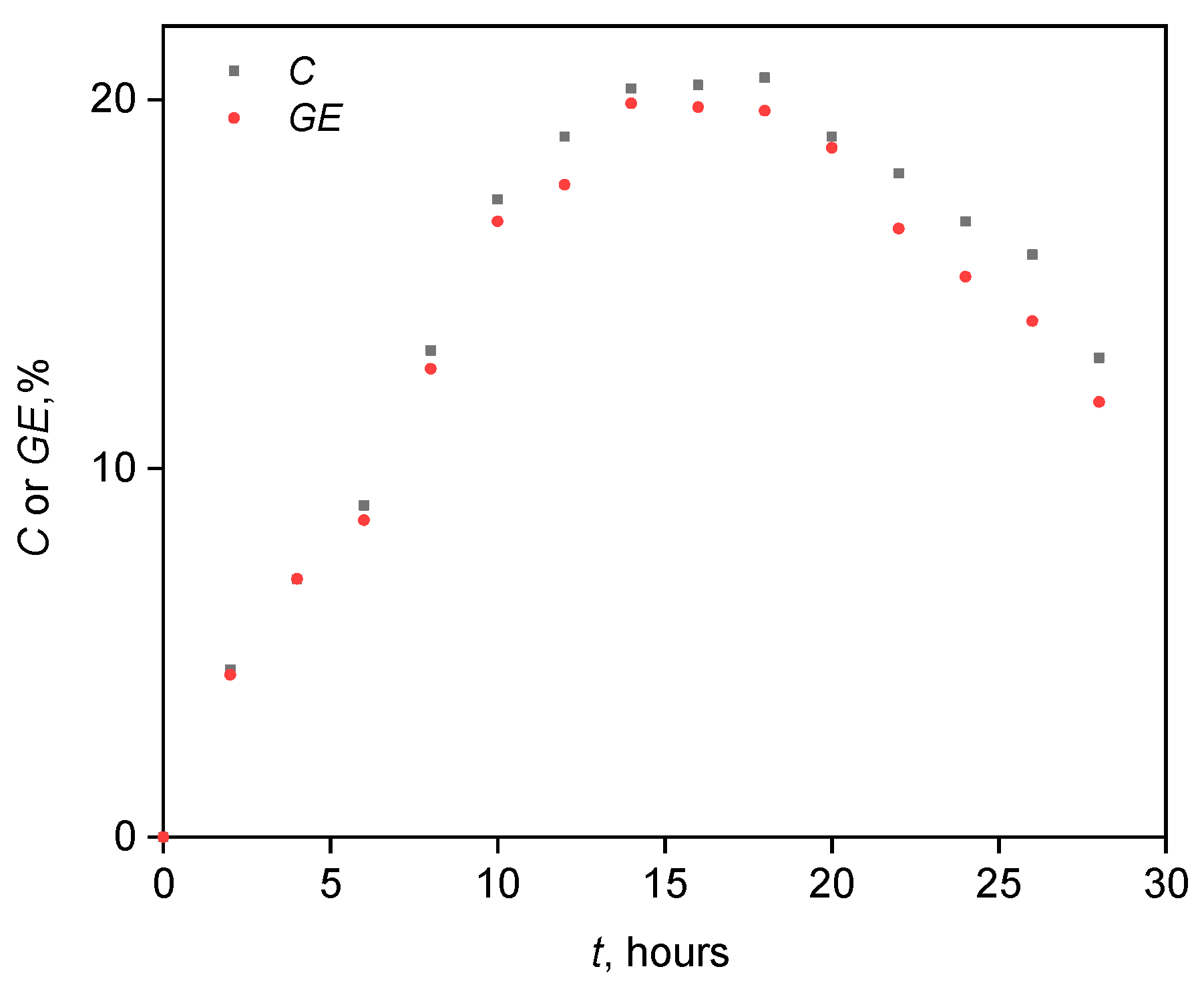

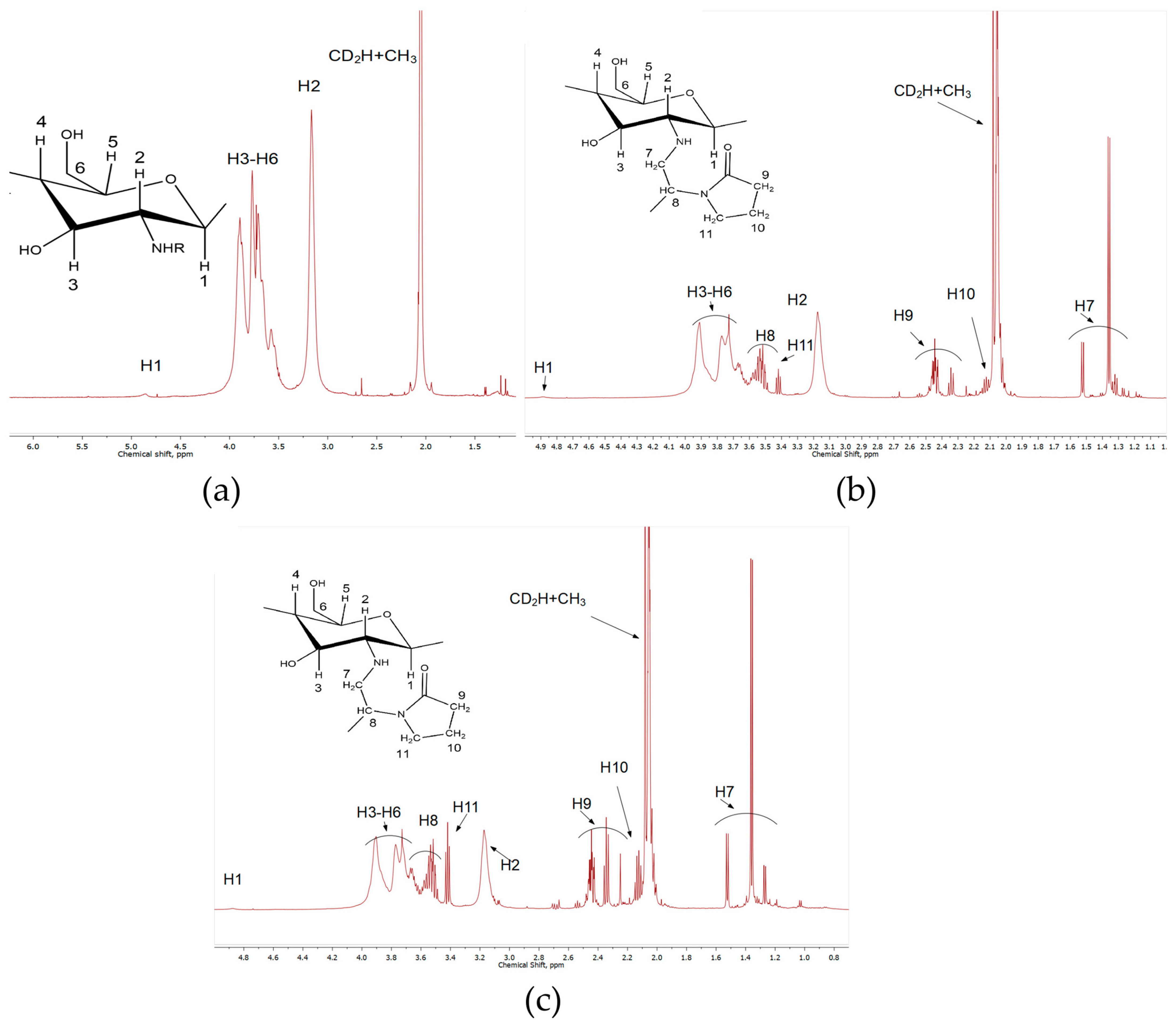

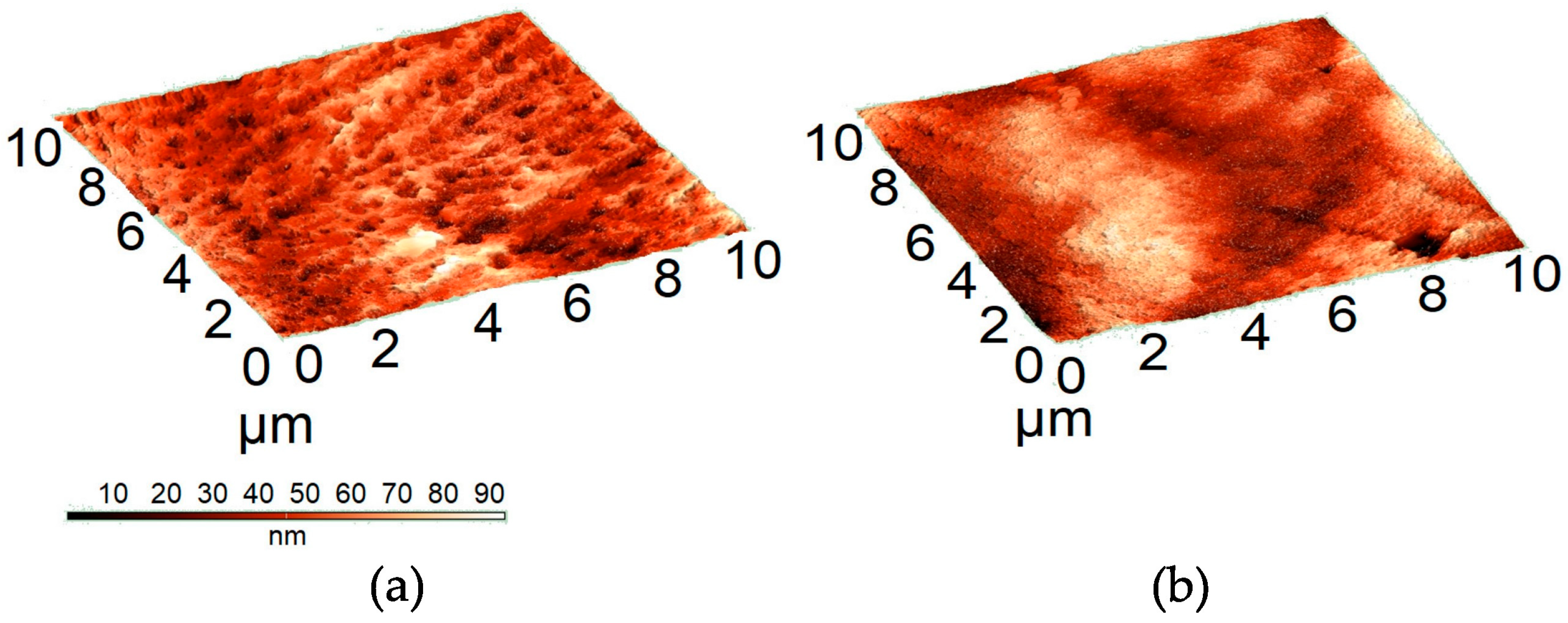
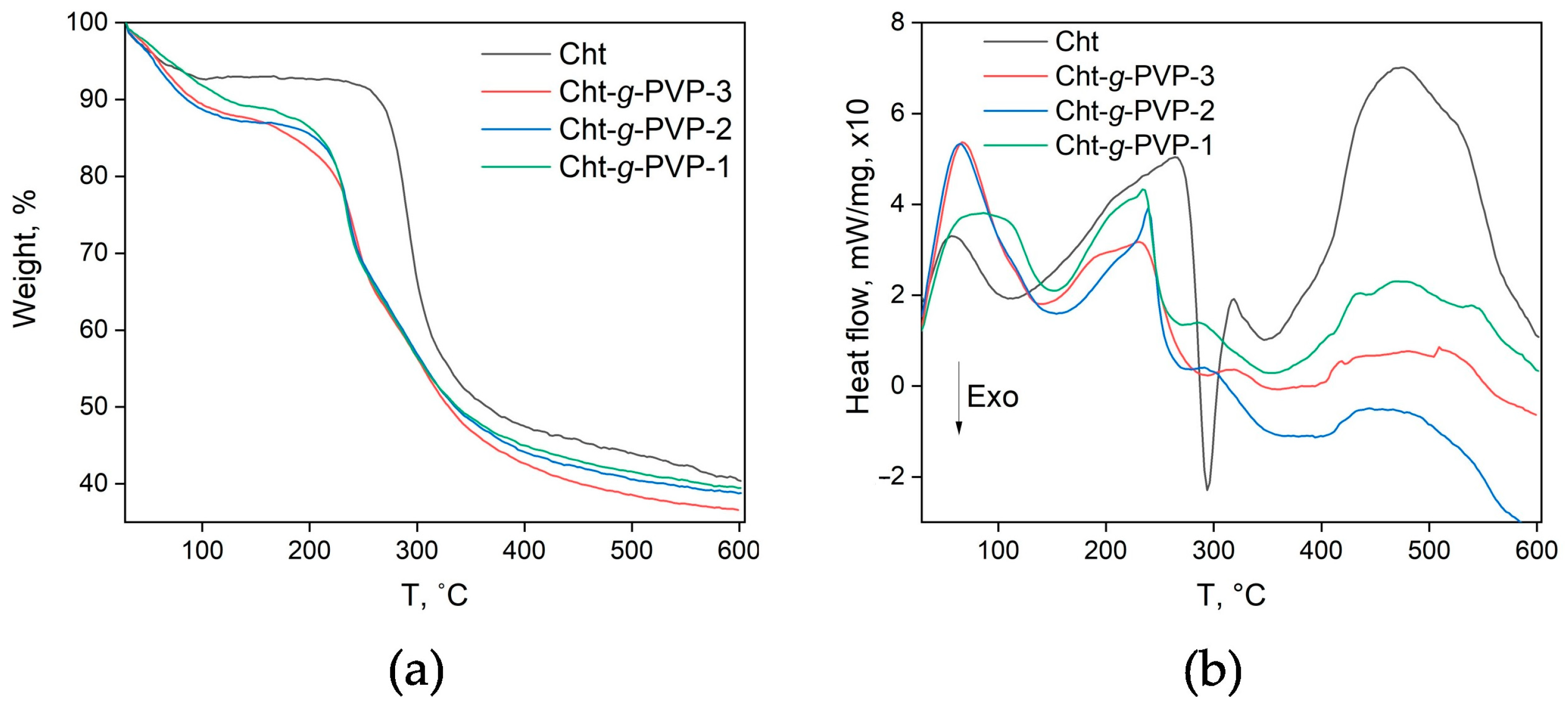
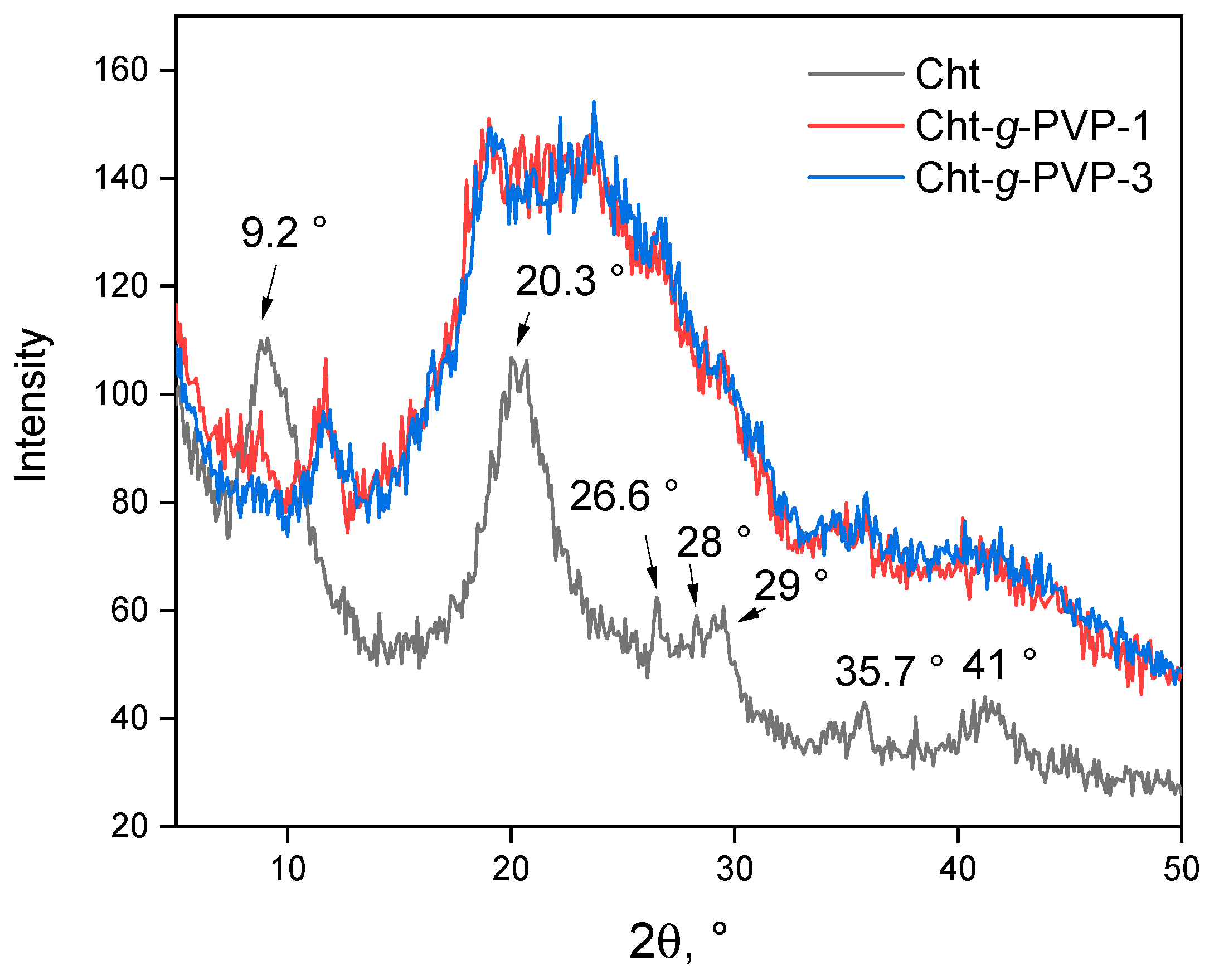
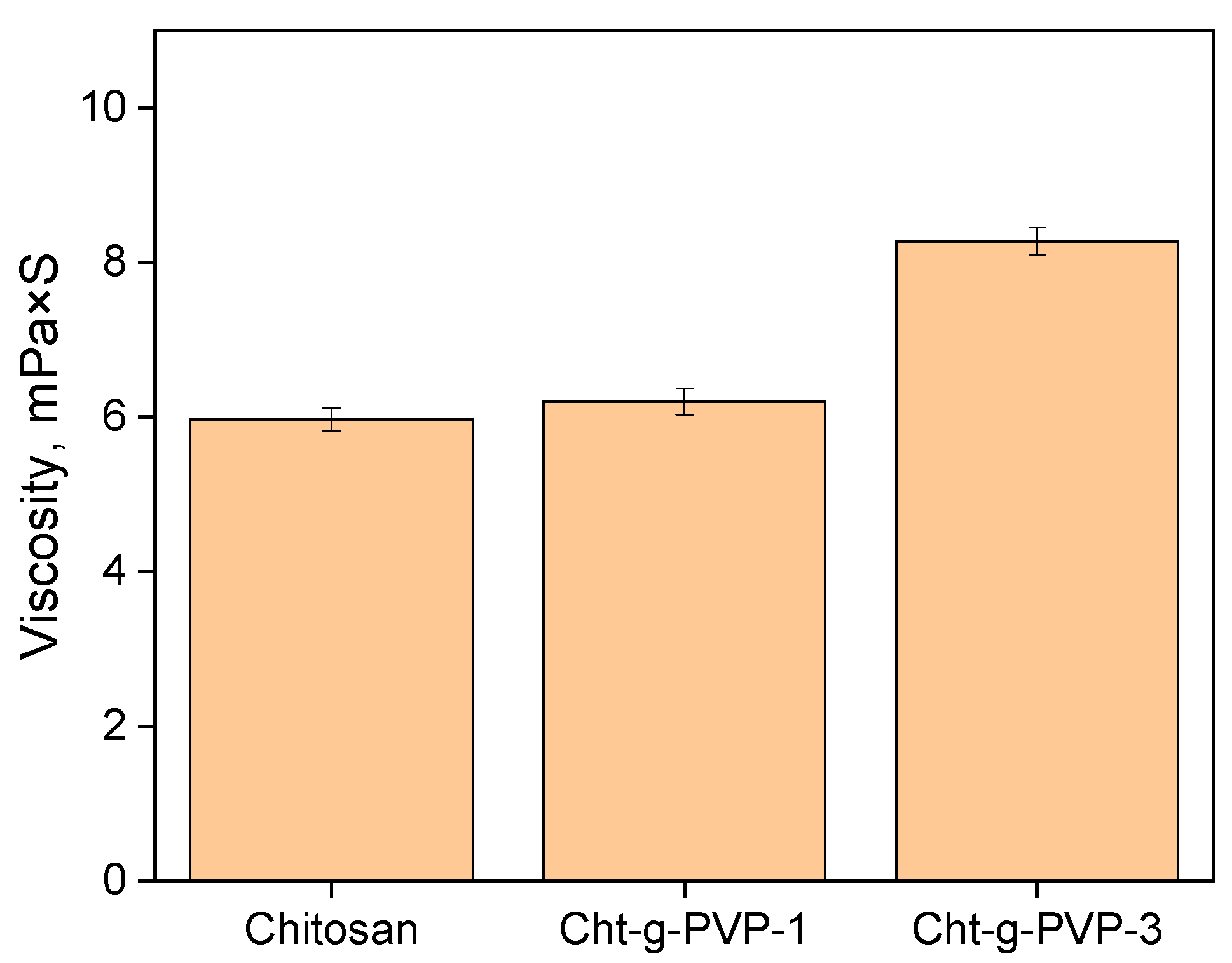
| T, °C | [PPS], mol × L–1 | n (PPS)/n (MBS), mol/mol | C, % | GE, % |
|---|---|---|---|---|
| 30 | 2 × 10−3 | 1/1 | 8.2 | 7.9 |
| 40 | 2 × 10−3 | 1/1 | 20.4 | 19.8 |
| 50 | 2 × 10−3 | 1/1 | 34.5 | 17.1 |
| 40 | 2 × 10−2 | 1/1 | 26.3 | 17.4 |
| 40 | 2 × 10−4 | 1/1 | 13.8 | 12.9 |
| 40 | 2 × 10−3 | 1/0.5 | 11.2 | 9.7 |
| 40 | 2 × 10−3 | 1/2 | 13.9 | 9.6 |
| Copolymer | n (Cht)/n (VP), mol/mol | C, % | PVP in Copolymer, % w | GE, % | FG × 102 | Mw of Grafted PVP |
|---|---|---|---|---|---|---|
| Cht-g-PVP-1 | 1/3 | 24.6 | 34.5 | 23.7 | 1.82 | 4900 |
| Cht-g-PVP-2 | 1/5 | 20.4 | 42.2 | 19.8 | 3.10 | 6300 |
| Cht-g-PVP-3 | 1/10 | 17.2 | 53.6 | 15.7 | 4.05 | 11,500 |
| Copolymer | MIC, μg × mL−1 | CC50, μg × mL−1 | |
|---|---|---|---|
| S. aureus | E. coli | ||
| Cht-g-PVP-1 | 1024 | 2048 | 3507 |
| Cht-g-PVP-3 | 2048 | >2048 | ~24,000 |
| Benzalkonium chloride | 2 | 64 | 0.5 |
Disclaimer/Publisher’s Note: The statements, opinions and data contained in all publications are solely those of the individual author(s) and contributor(s) and not of MDPI and/or the editor(s). MDPI and/or the editor(s) disclaim responsibility for any injury to people or property resulting from any ideas, methods, instructions or products referred to in the content. |
© 2024 by the authors. Licensee MDPI, Basel, Switzerland. This article is an open access article distributed under the terms and conditions of the Creative Commons Attribution (CC BY) license (https://creativecommons.org/licenses/by/4.0/).
Share and Cite
Lavlinskaya, M.S.; Sorokin, A.V.; Mikhaylova, A.A.; Kuznetsov, E.I.; Baidamshina, D.R.; Saranov, I.A.; Grechkina, M.V.; Holyavka, M.G.; Zuev, Y.F.; Kayumov, A.R.; et al. The Low-Waste Grafting Copolymerization Modification of Chitosan Is a Promising Approach to Obtaining Materials for Food Applications. Polymers 2024, 16, 1596. https://doi.org/10.3390/polym16111596
Lavlinskaya MS, Sorokin AV, Mikhaylova AA, Kuznetsov EI, Baidamshina DR, Saranov IA, Grechkina MV, Holyavka MG, Zuev YF, Kayumov AR, et al. The Low-Waste Grafting Copolymerization Modification of Chitosan Is a Promising Approach to Obtaining Materials for Food Applications. Polymers. 2024; 16(11):1596. https://doi.org/10.3390/polym16111596
Chicago/Turabian StyleLavlinskaya, Maria S., Andrey V. Sorokin, Anastasia A. Mikhaylova, Egor I. Kuznetsov, Diana R. Baidamshina, Igor A. Saranov, Margaryta V. Grechkina, Marina G. Holyavka, Yuriy F. Zuev, Ayrat R. Kayumov, and et al. 2024. "The Low-Waste Grafting Copolymerization Modification of Chitosan Is a Promising Approach to Obtaining Materials for Food Applications" Polymers 16, no. 11: 1596. https://doi.org/10.3390/polym16111596
APA StyleLavlinskaya, M. S., Sorokin, A. V., Mikhaylova, A. A., Kuznetsov, E. I., Baidamshina, D. R., Saranov, I. A., Grechkina, M. V., Holyavka, M. G., Zuev, Y. F., Kayumov, A. R., & Artyukhov, V. G. (2024). The Low-Waste Grafting Copolymerization Modification of Chitosan Is a Promising Approach to Obtaining Materials for Food Applications. Polymers, 16(11), 1596. https://doi.org/10.3390/polym16111596









